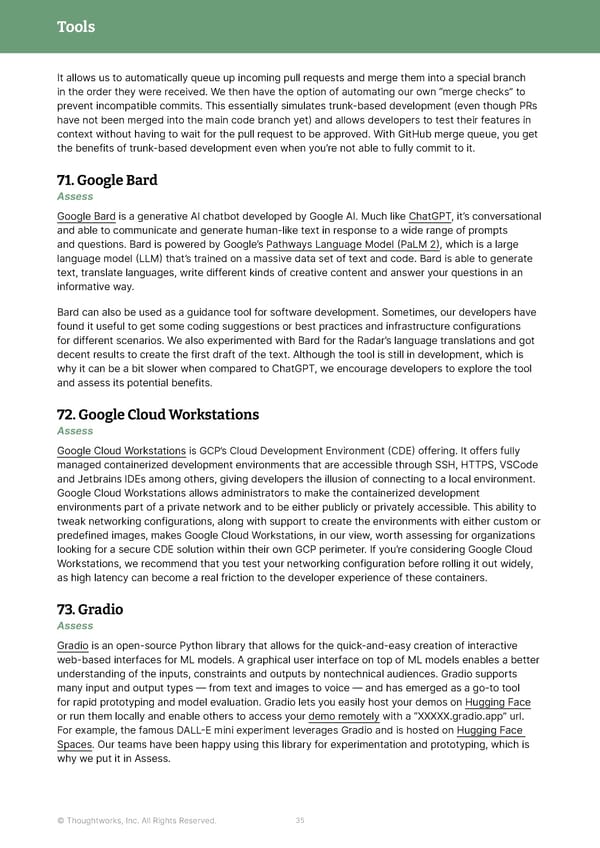Tools It allows us to automatically queue up incoming pull requests and merge them into a special branch in the order they were received. We then have the option of automating our own “merge checks” to prevent incompatible commits. This essentially simulates trunk-based development (even though PRs have not been merged into the main code branch yet) and allows developers to test their features in context without having to wait for the pull request to be approved. With GitHub merge queue, you get the benefits of trunk-based development even when you’re not able to fully commit to it. 71. Google Bard Assess Google Bard is a generative AI chatbot developed by Google AI. Much like ChatGPT, it’s conversational and able to communicate and generate human-like text in response to a wide range of prompts and questions. Bard is powered by Google’s Pathways Language Model (PaLM 2), which is a large language model (LLM) that’s trained on a massive data set of text and code. Bard is able to generate text, translate languages, write different kinds of creative content and answer your questions in an informative way. Bard can also be used as a guidance tool for software development. Sometimes, our developers have found it useful to get some coding suggestions or best practices and infrastructure configurations for different scenarios. We also experimented with Bard for the Radar’s language translations and got decent results to create the first draft of the text. Although the tool is still in development, which is why it can be a bit slower when compared to ChatGPT, we encourage developers to explore the tool and assess its potential benefits. 72. Google Cloud Workstations Assess Google Cloud Workstations is GCP’s Cloud Development Environment (CDE) offering. It offers fully managed containerized development environments that are accessible through SSH, HTTPS, VSCode and Jetbrains IDEs among others, giving developers the illusion of connecting to a local environment. Google Cloud Workstations allows administrators to make the containerized development environments part of a private network and to be either publicly or privately accessible. This ability to tweak networking configurations, along with support to create the environments with either custom or predefined images, makes Google Cloud Workstations, in our view, worth assessing for organizations looking for a secure CDE solution within their own GCP perimeter. If you’re considering Google Cloud Workstations, we recommend that you test your networking configuration before rolling it out widely, as high latency can become a real friction to the developer experience of these containers. 73. Gradio Assess Gradio is an open-source Python library that allows for the quick-and-easy creation of interactive web-based interfaces for ML models. A graphical user interface on top of ML models enables a better understanding of the inputs, constraints and outputs by nontechnical audiences. Gradio supports many input and output types — from text and images to voice — and has emerged as a go-to tool for rapid prototyping and model evaluation. Gradio lets you easily host your demos on Hugging Face or run them locally and enable others to access your demo remotely with a “XXXXX.gradio.app” url. For example, the famous DALL-E mini experiment leverages Gradio and is hosted on Hugging Face Spaces. Our teams have been happy using this library for experimentation and prototyping, which is why we put it in Assess. © Thoughtworks, Inc. All Rights Reserved. 35
 Thoughtworks Technology Radar Page 34 Page 36
Thoughtworks Technology Radar Page 34 Page 36